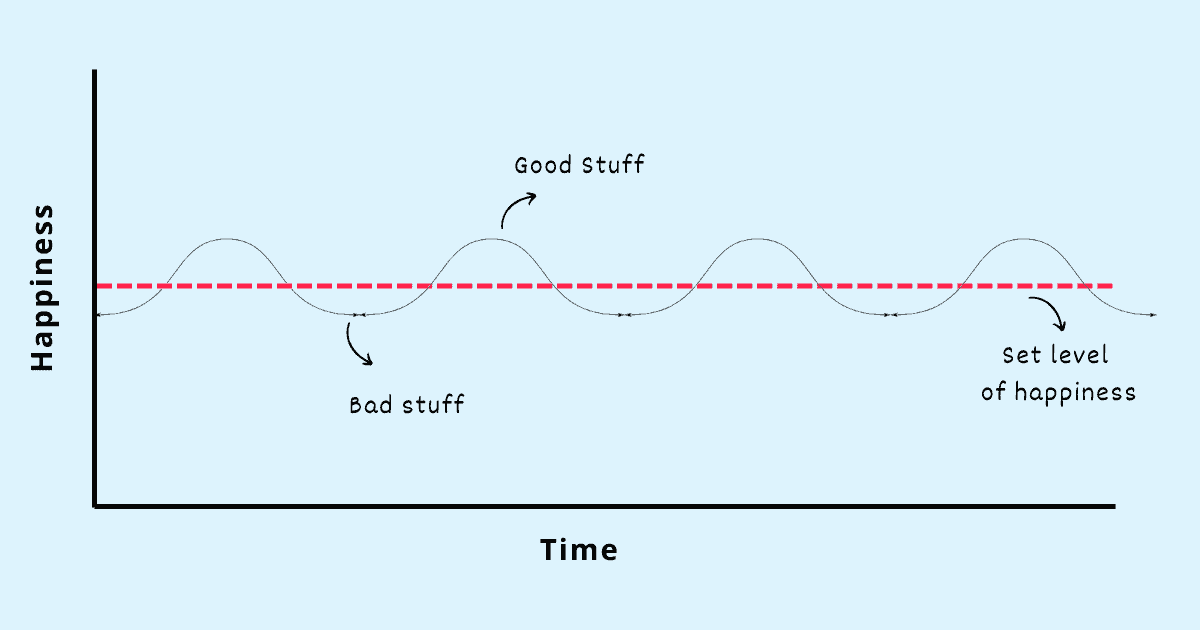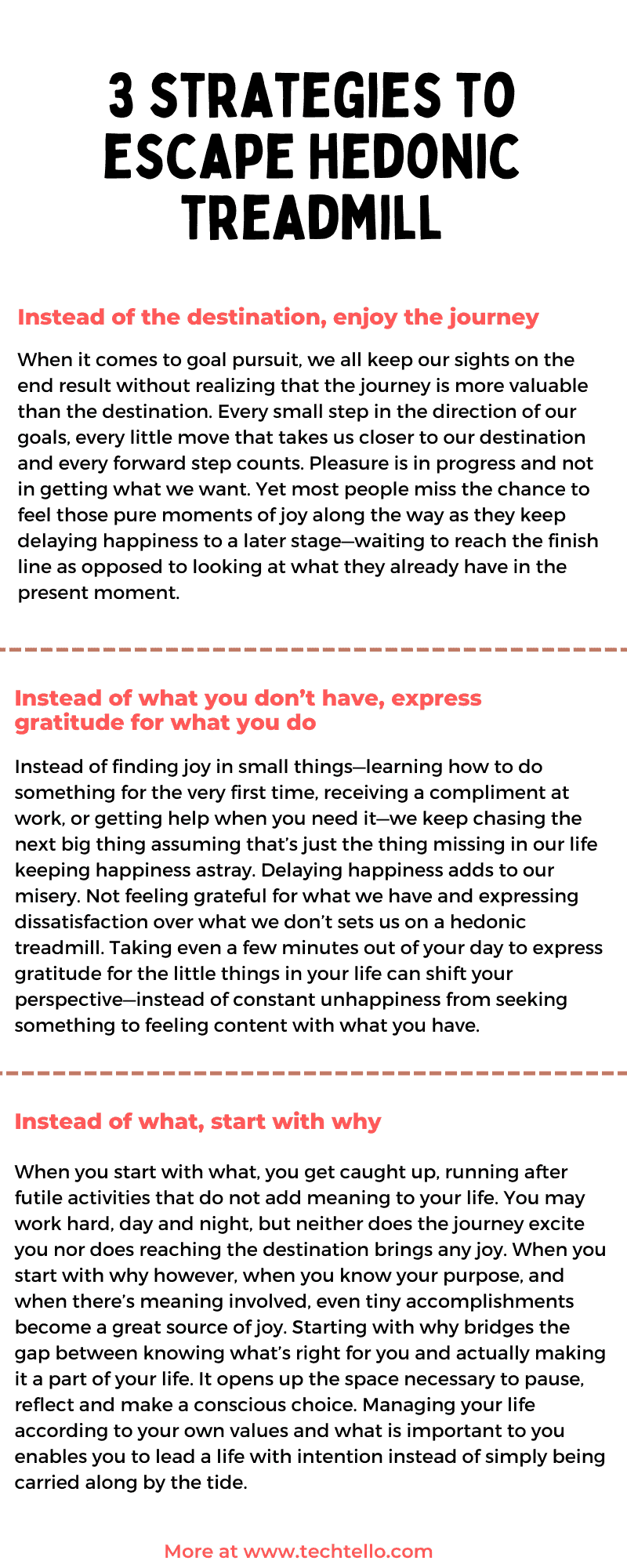Stuck on the Hedonic Treadmill? Here’s How to Escape It

The constant desire to improve ourselves and our life situation, seeking a better life, or the pursuit of pleasure is what keeps the human race thriving. But it also sets us on a hedonic treadmill constantly chasing the next big target.
We set goals and expectations—getting the next big promotion, completing a complex task or finishing up a really big project. We run to gain those things, often working every waking hour and going to extremes to improve ourselves imagining all along the way how happy we would be when we achieve this goal. But once we succeed or reach that destination, instead of being euphoric, the feeling is more of a relief—getting a closure on all the effort leading up to this moment. The happiness—if it does show up—is only momentary, often lasting a few hours, days or sometimes even a week.
Before we know it, we are back on the treadmill chasing the next big target—a bigger goal, a better responsibility or anything else that will make us happier. We run again, we set ourselves a new goal only to end up with our baseline—our set level of happiness. The term called Hedonic treadmill or the hedonic adaptation coined by the psychologists Brickman and Campbell in the 70s states that most people return to their base level of happiness regardless of the events—positive or negative—that happens in their life.
In Happiness Hypothesis, Jonathan Haidt says this keeps us stuck on the hedonic treadmill “On an exercise treadmill you can increase the speed all you want, but you stay in the same place. In life, you can work as hard as you want, and accumulate all the riches, fruit trees, and concubines you want, but you can’t get ahead. Because you can’t change your “natural and usual state of tranquility,” the riches you accumulate will just raise your expectations and leave you no better off than you were before. Yet, not realizing the futility of our efforts, we continue to strive, all the while doing things that help us win at the game of life. Always wanting more than we have, we run and run and run, like hamsters on a wheel.”
While we all have a set point (genetically encoded at birth) that accounts for 50% of our predisposition for happiness, there’s still plenty of leeway for improvement. Even if you’re someone who’s predisposed to gravitate towards sadness or depression, you aren’t doomed to never be happy. A good 40% of happiness is under your control leaving 10% to external circumstances that you have no control over.
With the right strategies you can escape the hedonic treadmill.
3 strategies to escape the hedonic treadmill
Instead of the destination, enjoy the journey
Think of the goal of running a marathon. Reaching the finish line will bring a strong sense of relief as if a heavy weight has been lifted from your shoulders but the feeling of pleasure will only be short-lived. Compare that fleeting happiness with the joy you feel every step of the way—every step closer to your goals brings a sense of progress which is often more rewarding and fulfilling.
When it comes to goal pursuit, we all keep our sights on the end result without realizing that the journey is more valuable than the destination. Every small step in the direction of our goals, every little move that takes us closer to our destination and every forward step counts. Pleasure is in progress and not in getting what we want. The experience is very similar to a roller-coaster ride where the thrill comes when the ride is on and not when it hits brakes and reaches the end.
Yet most people miss the chance to feel those pure moments of joy along the way as they keep delaying happiness to a later stage—waiting to reach the finish line as opposed to looking at what they already have in the present moment.
Psychologist Richard Davidson identified two types of positive effects that result when trying to achieve a certain goal:
- Pre-goal attainment positive affect which is the pleasurable feeling you get as you make progress toward a goal.
- Post-goal attainment positive affect which comes once you have achieved your goal.
Research shows pre-goal attainment is more long-lasting while post-goal attainment is only short-lived. Jonathan Haidt calls it the progress principle “Pleasure comes more from making progress toward goals than from achieving them. The final moment of success is often no more thrilling than the relief of taking off a heavy backpack at the end of a long hike. If you went on the hike only to feel that pleasure, you are a fool.”
Wheel of Life Assessment
Use this wheel of life worksheet to enhance your overall well-being by identifying and aligning different areas of your life.
Instead of what you don’t have, express gratitude for what you do
Instead of finding joy in small things—learning how to do something for the very first time, receiving a compliment at work, or getting help when you need it—we keep chasing the next big thing assuming that’s just the thing missing in our life keeping happiness astray.
Instead of letting happiness loose, we stuff it inside a box conditioned to get out only on specific occasions:
I’ll be happy when I get promoted.
I’ll be happy when I get that big opportunity.
I’ll be happy when I have so much money.
Delaying happiness adds to our misery. Not feeling grateful for what we have and expressing dissatisfaction over what we don’t sets us on a hedonic treadmill—we keep craving the happiness boost that comes with achieving something but neither does it last long nor is it as intense as we had imagined.
Instead of the “I’ll be happy when I…” say to yourself “I’m happy with…”
Taking even a few minutes out of your day to express gratitude for the little things in your life—the rising sun, a warm cup of coffee, a healthy meal, going for a run, spending time with your family—can shift your perspective—instead of constant unhappiness from seeking something to feeling content with what you have.
When you look for things you’re grateful for rather than things you lack you operate from a place of abundance. Scarcity mindset—I don’t have enough—upsets you while abundance mindset—I have enough—enlarges your capacity for happiness. Reflecting on and appreciating the good things in your life leads to contentment and inner peace, two important factors in your overall well-being.
As Roy T. Bennett puts it in The Light in the Heart “Be grateful for what you already have while you pursue your goals. If you aren’t grateful for what you already have, what makes you think you would be happy with more.”
Instead of what, start with why
Viktor Frankl who survived the holocaust wrote about how people who survived the death camps weren’t necessarily the strongest, but they had a clear purpose in life. It was their purpose that made them endure even the most difficult and horrifying conditions.
He writes in Man’s Search for Meaning “Life is not primarily a quest for pleasure, as Freud believed, or a quest for power, as Alfred Adler taught, but a quest for meaning. The great task for any person is to find meaning in his or her life.”
When you start with what, you get caught up, running after futile activities that do not add meaning to your life. You may work hard, day and night, but neither does the journey excite you nor does reaching the destination brings any joy. When you start with why however, when you know your purpose, and when there’s meaning involved, even tiny accomplishments become a great source of joy.
Starting with why bridges the gap between knowing what’s right for you and actually making it a part of your life. It opens up the space necessary to pause, reflect and make a conscious choice. Managing your life according to your own values and what is important to you enables you to lead a life with intention instead of simply being carried along by the tide.
To clarify your why, here are some questions to ask yourself:
- Why is this important to me?
- Why do I want it?
- What will accomplishing this help me achieve?
- How does it align with my goals in life?
- What’s the cost of doing it?
- What’s the cost of not doing it?
Remember this: Find meaning in what you do, start with why. Pleasure will follow.
Summary
- Our default setting makes us go after bigger and better things in life, which is useful from an advancement perspective. The problem happens when we are never satisfied and keep chasing the next big thing.
- Setting goals is useful in itself, but what if you only care about the end goal without enjoying the journey. Once you reach the target, you may feel happy, but that happiness is only short-lived and fleeting.
- Moving from one goal to another in search of happiness sets you on a hedonic treadmill.
- Pleasure is in progress and not reaching the final destination. Enjoying the journey can help you escape the hedonic treadmill.
- Instead of expressing dissatisfaction over what you don’t have, practice gratitude for the little things in your life. They will lead to more contentment and happiness in the long term.
- Start with why. Knowing the purpose of doing something and connecting it to the meaning and purpose of your life is in itself a source of joy.


































